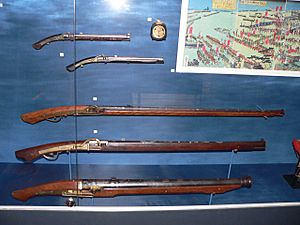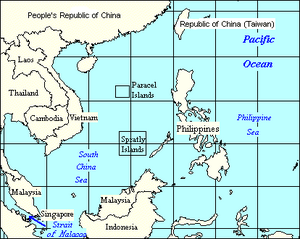Fernão Mendes Pinto facts for kids
Quick facts for kids
Fernão Mendes Pinto
|
|
|---|---|

A possible picture of Fernão Mendes Pinto.
|
|
| Born | 1509 Montemor-o-Velho, Kingdom of Portugal
|
| Died | 8 July 1583 Pragal, Almada, Kingdom of Portugal
|
| Nationality | Portuguese |
| Occupation | explorer and writer |
| Known for | Pilgrimage |
Fernão Mendes Pinto (born around 1509 – died July 8, 1583) was a Portuguese explorer and writer. He traveled a lot, and his adventures are written in his famous book, Pilgrimage (called Peregrinação in Portuguese).
Some people wondered if his stories were true because they seemed so amazing. This led to a funny saying in Portuguese: "Fernão, Mentes? Minto!" It's a play on words that means "Fernão, are you lying? I am lying!" But many parts of his book have been proven true, especially through records of his work for the Portuguese king and his connections with Jesuit missionaries.
Contents
Early life
Fernão Mendes Pinto was born in 1509 in Montemor-o-Velho, Portugal. His family was not rich. He had two brothers and two sisters.
When he was about 12 years old, his uncle took him to Lisbon. This was to help him find a better life. Pinto worked for a noblewoman for about a year and a half. Then, he ran away.
He found a job as a ship's boy on a ship going to Setúbal. But French pirates attacked the ship. They left Pinto and the other passengers on the shore.
Pinto made his way to Setúbal. There, he worked for a knight for four years. After that, he worked for Jorge de Lencastre, a powerful leader. Pinto had a comfortable life there, but he wanted more adventure. So, at 28, he decided to join the Portuguese India Armadas. These were fleets of ships sailing to India.
Voyages
Pinto's travels were long and covered many parts of the world. First, he sailed from Portugal to India. Then, he explored areas around the Red Sea and the Persian Gulf. After that, he went to East India, Sumatra, Siam, China, and Japan. Finally, he returned to Europe.
First trip to India
On March 11, 1537, Pinto left Lisbon for India. He arrived in Diu on September 5. Diu was a strong town controlled by the Portuguese.
Pinto joined a Portuguese group going to the Red Sea. Their job was to deliver a message to Portuguese soldiers in Ethiopia. After a battle with Turkish ships, the Portuguese were defeated. Pinto and his crew were taken to Mocha and sold as slaves.
Pinto was sold to a cruel master. Later, a Jewish merchant helped him. Pinto traveled with this merchant to Hormuz, a big trading town. There, the Portuguese king paid for Pinto's freedom. He was then made a captain and a special judge for Indian affairs.
Malacca and the Far East
After being freed, Pinto sailed to Goa. He was then sent to Malacca in 1539. Malacca was an important Portuguese base. Pinto's job was to make friends with local kingdoms. These kingdoms were allies with the Portuguese against other groups.
Patani
After his mission in Sumatra, Pinto went to Patani. This was on the eastern side of the Malay Peninsula. From there, he tried to deliver goods to Siam, but pirates stole them. Pinto chased the pirates with a friend. He continued trading in the South China Sea.
China
Pinto entered China from the Yellow Sea. He explored a tomb of the Emperor of China. Pinto's ship was wrecked, and the Chinese captured him. He was sentenced to one year of hard work on the Great Wall of China.
Before he finished his sentence, Tatar invaders captured him. He worked for the Tatars and traveled with them to Cochinchina. This area is now part of Cambodia and Vietnam. Pinto wrote about meeting a "pope-like" man there. This person had never heard of Europe. Pinto and two friends escaped on a Chinese pirate ship. They were shipwrecked on the Japanese island of Tanegashima.
Japan

Pinto said he was the first European to land in Japan in 1543. He also claimed to have brought the arquebus (a type of gun) to Japan. However, it is now known that other Portuguese traders visited Japan a year earlier. The Japanese quickly copied the gun. It was used in their civil wars and called the tanegashima.
Pinto helped with trade between the Portuguese and Japan. In 1549, he returned to Japan with Saint Francis Xavier, a Catholic missionary. In 1554, Pinto joined the Society of Jesus (a religious group). He gave a lot of his money to their mission. Pinto returned to Japan again between 1554 and 1556. He worked as an ambassador for the Portuguese. He left the Jesuits in 1557.
Martaban and Java
Pinto returned to Malacca. Then he was sent to Martaban. He arrived during a war and was captured by the Burmese. He later escaped to Goa.
On his way back to Goa, Pinto was sent to Bantam, Java. His job was to buy black pepper. Again, his ship was wrecked. He faced many difficulties and was captured again. He was eventually bought by a merchant and returned to Sunda.
Siam
Pinto borrowed money and traveled to Siam. There, he saw the King of Siam fighting a war. Pinto's writings give important details about this war.
Return to Portugal
On September 22, 1558, Pinto finally returned to Portugal. He was already famous in Europe. This was because one of his letters had been published in 1555.
Pinto spent several years trying to get a reward for his service to the king. He married Maria Correia Barreto and had at least two daughters. In 1562, he bought a farm. Fernão Mendes Pinto died at his farm on July 8, 1583.
Memoir Peregrinação
Pinto started writing his memories in 1569. His book, Peregrinação (Pilgrimage), was published after he died, in 1614. Pinto didn't have a formal education like other writers of his time. But his amazing experiences and intelligence helped him create a very important book. He also wrote about how the Portuguese acted in the Far East.
His stories were so vivid and unbelievable that some people didn't believe them. This is where the saying "Fernão, Mentes? Minto!" came from. It's a Portuguese pun on his name.
The book might be a bit different from Pinto's original writings. Some parts were changed or removed. For example, there are fewer mentions of the Society of Jesus, even though Pinto worked closely with them. His book is based on his memories, so some details might not be perfectly accurate. However, it shows how Asian cultures affected Europeans. It also gives a good look at what the Portuguese did in the East.
One of Pinto's most debated claims is that he was the first European to visit Japan. He also claimed to have brought the arquebus (gun) to Japan. Another debated claim is that he fought in Java against Muslims. Historians have studied these claims. Even if not every detail is perfectly true, many historians agree that Pinto's accounts fit with historical events. His book is seen as one of the most complete European stories of 16th-century Asian history.
Legacy
In 1978, a crater on Mercury was named Mendes Pinto after him.
A high school in Almada, Portugal, built in 1965, was named in his honor. In 2011, a special 2 euro coin was made to celebrate 500 years since Pinto's birth.
See also
- Exploration of Asia
- In Spanish: Fernão Mendes Pinto para niños







